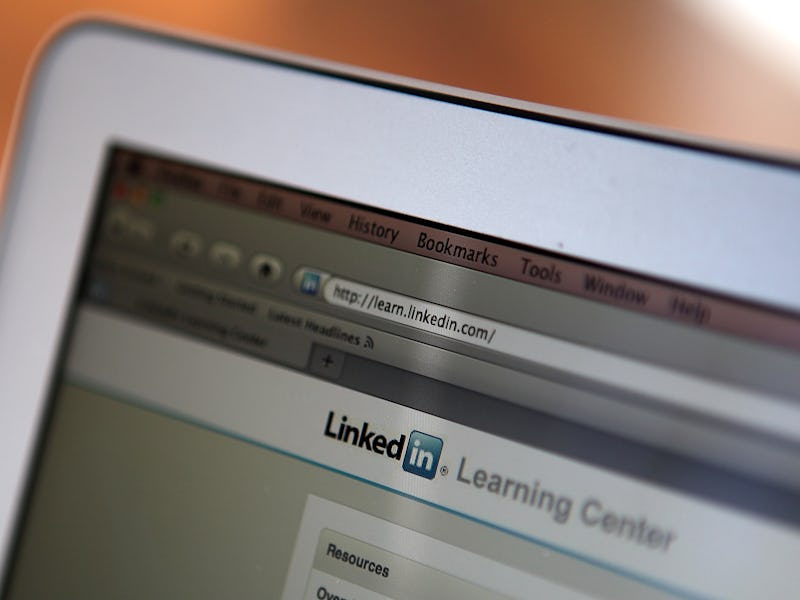How to Navigate the Professional Etiquette of LinkedIn Connections
Are we friends? Are we colleagues? Is my résumé a hot mess? A couple of experts tell my clueless ass.

I admit, I use LinkedIn. Well, sort of. I don’t really know what I’m doing on there and whenever one of my mature friends — you know the type: steady job, married, owners of more than a beer bottle collection — hails its impressive features, I nod and then go on Instagram. But, seeing how I’m now 33 and could use another one of those nebulous “full-time jobs,” I contacted a couple of authorities on the platform to tell me how to manage its trickiest pitfalls.
Donna Serdula is the the author of LinkedIn Makeover and hosts a site bearing its name. I phoned her offices in New Jersey to — wait for it — connect. “My belief is that you shouldn’t be shy on LinkedIn. Connect, connect, and then connect some more,” Serdula tells me. “Really make your online network reflect your offline network. So many people do not connect with enough people: They have 100 connections, maybe. Then they scratch their head and wonder why they’re seeing no benefit. LinkedIn is like an old-fashioned Rolodex and an empty Rolodex is useless.” Preach.
So, how do you jump in? “I don’t know if this is mind-blowing, but you personalize those invites,” she says. “Look to see what you have in common, who you know. It’s almost like ‘Six Degrees of Kevin Bacon,’ except this is the ‘Three Degrees of Reid,’ she tells me, referencing LinkedIn co-founder Reid Hoffman. “You request a connection with a nice, little note that says, ‘Hey, we don’t know each other, but we know a lot of the same people.’ As long as you personalize that invite and you have a profile picture that’s not atrocious, people will connect with you.” Noted: Change my profile picture.
“As a married woman who’s on LinkedIn, I get asked out quite a bit,” she says when I ask her if it’s kosher to ask people out via the social network. “There are people who do use it like eHarmony or Tinder. It’s not the place. LinkedIn is professional; it’s for your industry, for your career. Don’t go in that direction; you’re hurting yourself. I think LinkedIn is a fabulous place to check people out. So, perhaps, if you find someone on one of those other sites and you want to learn a little bit about them, you can do some recon on LinkedIn before that first date.” Noted: Do not ask Donna out during this interview.
So, how about that sparkly, fancypants “premium” level? Is it worth it? “Don’t worry about what package you might have, just get on it and use it for free. And really use it,” Serdula says. “Once you start using it, it’ll be very clear to you when it’s time to upgrade. Because LinkedIn will let you know. You’re going to start to feel constrained. You’re going to try to reach out to people and they’re going to say, ‘Sorry, emails are only available to paying members.’ You’re going to know when it’s time.”
The big revelation for me, though, is how this network isn’t just a one-night stand between your Facebook account and your résumé. In fact, just blow up your résumé when you’re hammering out that LinkedIn version of hirable you. “Your résumé is your professional past. Your LinkedIn profile is your reputation and your career future,” Serdula says. “Résumés are typically very dry and detail-oriented — very granular. A LinkedIn profile should be more conversational and compelling.
I ask her if there’s any place for humor on LinkedIn. “I do think it’s important to have some personality, but you don’t want to come across as flaky,” she says. “It’s important to feel the warmth of your personality. But you have to balance it. You have to come across as professional and human.” Serdula has an Easter egg at the bottom of her profile, joking that her humanities degrees set her up for career in the fast food industry. Same, Donna. Same.
Next, I hit up Wendy S. Enelow, executive résumé writer and co-author of Modernize Your Resume: Get Noticed … Get Hired. She takes a curatorial approach. “The most important thing is to find balance — between volume of LinkedIn connections and quality of connections. It’s great to build a network that is large and vast, but you have to ask yourself what value you can bring to those in your network and what value you can receive from others. LinkedIn is a platform for building relationships — with people you know and people you don’t — to leverage the best possible results for yourself and everyone in your network.” Keep this street moving two directions then, and find people you can do things for, even if you don’t know yet what they can do for you.
Then, Enelow explains to me that asking people out on LinkedIn is not advisable and probably, like Ms. Serdulo, wonders why I even asked that question.